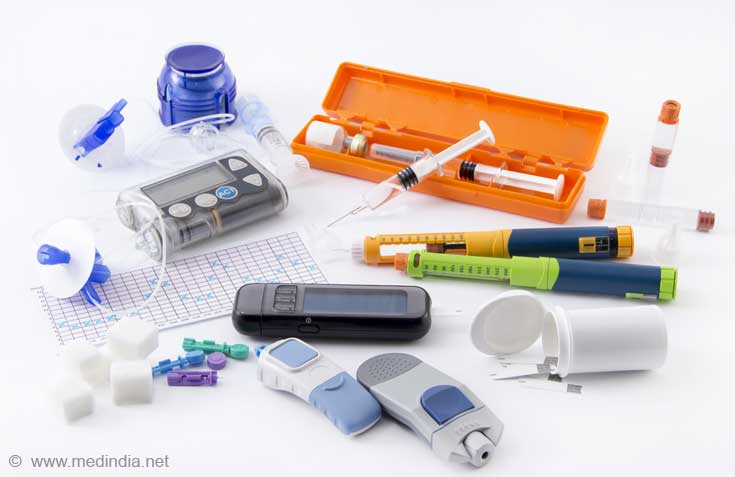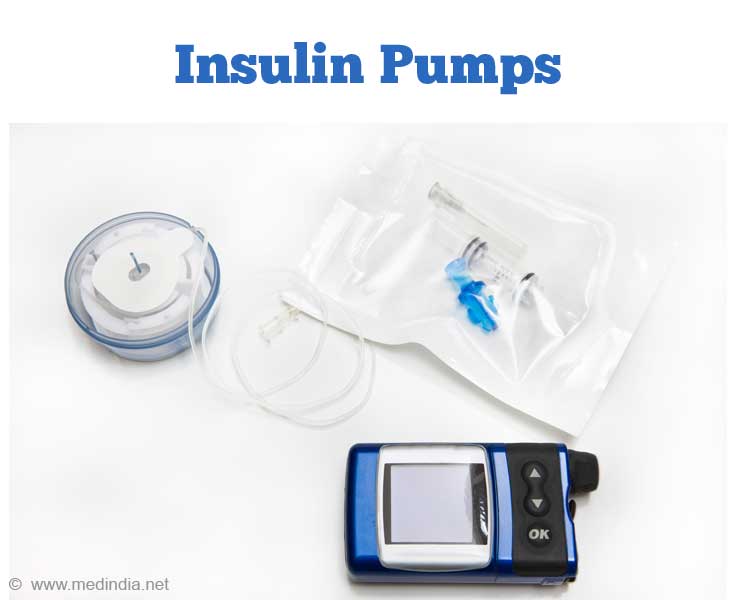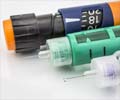- Katzung BG. Basic and Clinical Pharmacology. 12th edition
- Al-Tabakha MM, Arida AI. Recent Challenges in Insulin Delivery Systems: A Review. Indian J Pharm Sci. 2008 May-Jun; 70(3): 278–286. doi: 10.4103/0250-474X.42968
What is Insulin?
Laughter is the best medicine - unless you're diabetic, then insulin comes pretty high on the list. ~ Jasper Carrott
Insulin is a natural hormone that plays an important role in carbohydrate metabolism. It is produced in our body by an abdominal organ called pancreas. A problem with the pancreas could result in reduced insulin levels in the blood. This results in a well-known condition called diabetes, or more specifically type 1 diabetes.

Diabetes may also result if the body cells are resistant to the action of insulin. Thus, insulin is present in the body, but is unable to act adequately. This results in another type of diabetes, referred to as type 2 diabetes. Type 2 diabetes may also occur if there is overproduction of glucose by the liver. Type 2 diabetes patients are usually treated with anti-diabetes pills, but may require insulin in the later stages. A high blood glucose level may itself not be associated with significant symptoms except excessive urination, excessive thirst and excessive hunger. However, if the levels remain high over long durations, they cause complications in virtually every organ including the heart, kidneys, eyes and brain. On the other hand, a person with adequately controlled diabetes could lead a normal life.
Insulin - How it Works?
Sir Frederick Grant Banting discovered Insulin and when he delivered his Nobel Lecture at the Nobel Academy said:
‘Insulin is not a cure for diabetes; it is a treatment. It enables the diabetic to burn sufficient carbohydrates, so that proteins and fats may be added to the diet in sufficient quantities to provide energy for the economic burdens of life.’
Insulin plays an important role in carrying glucose molecules across cells, where they can be used to generate energy. When food passes through the digestive tract, glucose along with other nutrients gets absorbed into the blood. High glucose levels in the blood stimulate the release of insulin from the pancreas. This insulin facilitates the entry of the glucose molecules into the cells.
Insulin that is used in the treatment of diabetes works in the same way as natural insulin. The insulin is obtained through genetic engineering techniques. Once injected, it moves into the blood and helps the glucose molecules to enter the cells.
The body usually contains a basal level of insulin. Spurts of insulin are released following meals to deal with the additional glucose. Thus, during treatment, it is necessary to reproduce this physiological pattern.
- An intermediate or long acting insulin is given to manage the glucose levels throughout the day and night.
- While a rapid or short acting insulin is taken just before meals to cover the additional insulin requirement.
What are the Types of Insulin?
Older insulins were obtained from animals such as pigs and cows, and were associated with side effects. The newer insulins are obtained by genetic engineering techniques. They are given by subcutaneous injections, that is, they are injected just below the skin and are less reactive.
There are several types of insulin which can be classified according to their onset and duration of action:
- Rapid acting insulin includes insulin lispro, insulin aspart and insulin glulisine. These act within minutes of the injection, the peak effect is usually around 1 hour and their effect usually lasts only up to 4 -5 hours. They are the only insulins that can be used with subcutaneous pumps.
- Short acting insulin includes regular insulin. It acts within 30 minutes, its maximum effect is usually between 2 to 3 hours and the total effect lasts for around 5 to 8 hours. It is usually taken 30 to 45 minutes before a meal to take care of the glucose rise due to the meal. Besides begin administered subcutaneously, it can also be given into the vein in conditions like diabetic ketoacidosis, or after surgery or during severe infections in diabetes patients.
- Intermediate acting insulin is the NPH or Neutral protamine Hagedorn insulin. Its action begins around 2 to 5 hours after injection and lasts for around 4 to 12 hours.
- Long-acting insulin, which includes insulin glargine and insulin detemir. These begin their effect in 1 to 2 hours, and the effect lasts for more than 12 hours.

Which Insulin to Choose?
The choice of insulin and the dosage required is made by the health care provider. Premixed formulations are also available which reduce the number of injections.
Combinations currently available include insulin lispro plus neutral protamine lispro, insulin aspart plus neutral protamine aspart, and NPH and regular insulin.
How is Insulin Administered?
One of the main fears that people have about taking insulin is the need for multiple daily injections. However, once they get used to it, apprehensions disappear and it just becomes a part of the daily routine. Common sites for insulin injection include the outer arm, the lower anterior abdomen excluding the navel area, the thigh and the buttocks. These sites of injection should be rotated by the patient to give rest to previously injected site.
Insulin is administered into the subcutaneous tissue with one of the following devices:
- Insulin Syringe: Insulin is administered just under the skin with a special syringe. Patients are trained to withdraw the insulin from the vial and inject it just under the skin.
- Insulin Pens: These devices look like pens. They are convenient to carry and use at the workplace. The needle is extremely fine and therefore does not hurt the patient while injecting.
- Insulin pumps: It is a small device that is loaded with insulin and is carried on the patient’s body. It is connected to the patient by an infusion set. The pump releases the necessary amount of insulin based on its programming, which gets automatically injected into the patient via the infusion set. Thus, the need for repeated injections is avoided. However, care should be taken to ensure that there is no malfunction in the system, which can cause fluctuations in the blood glucose levels. Only the rapid acting insulins, insulin aspart, lispro and glulysine can be used with this device. The cost of a pump is much more as compared to insulin syringes.

- Injection port: It is like an infusion set that is fixed to the skin. The patient injects the insulin into the port instead of the skin. The same port can be used for a few days following which it may need to be replaced.
- Insulin jet injectors: It delivers insulin through the skin in the form of a spray at high pressure. Though these appear to be a great option to get away with repeated needle pricks, they do have their disadvantages like size, cost, associated noise, difficulty in adjusting pressure, pain and bruising at the site of the injection. Therefore, they may still not be the best option for all patients.
Several attempts are being made to bring about a revolution in the way in which patients receive insulin. While insulin inhalers are already in the market, others like patches, mouth sprays and pills are also being investigated. However, further large studies are necessary to ensure that these are effective and do not cause any new or unexpected side effects.
What Precautions should a person taking Insulin take?
Insulin treatment is associated with side effects. These include:
- Hypoglycemia or low blood sugar levels. This occurs if the dosage of the insulin was too high, the patient did not take in adequate amount of carbohydrates, or the body utilized the carbohydrates fast due to excessive physical activity. Symptoms of hypoglycaemia include palpitations, sweating, tremors and even convulsions. Mild cases may recover with oral sugar or glucose, while unconscious patients often require intravenous injections of glucose.
- Insulin resistance may arise during insulin treatment. The patient may require higher doses of insulin and may even need a change of formulation.
- Increased thickness of the subcutaneous fat could occur if the injection is given repeatedly at the same site. Therefore, the patient is advised not to inject into the same site repeatedly.
Some precautions that are advised in patients taking insulin are as follows:
- Follow the healthcare provider’s advice carefully with regard to the dosage and the technique of insulin administration.
- Monitor blood glucose on a regular basis as per your doctor’s advice. The urine should also be tested regularly for the presence of glucose, ketones and protein.
- If the physical activity level is likely to increase, make sure you consult your healthcare provider who may require changing the dosage.
- The insulin vial should be stored in a refrigerator but not in a freezer. Once, it is opened, it can be kept at room temperature but must be discarded in 30 days.
Most important, any patient with diabetes requires a strict diet control to achieve maximal effect with treatment.
Health Tips for Diabetics
- Diet is extremely important in patients with diabetes even if you are on treatment. Your medications will work best if you control your sugar intake.
- Always carry a card with you to indicate that you are a diabetic on insulin, in case any emergency situation arises.
- A small amount of sugar will do no harm, but a low blood sugar level can affect even the brain. Hence carry a small packet of sugar or some sweets with you. If you have symptoms of palpitations, sweating etc., do not hesitate to take it.








